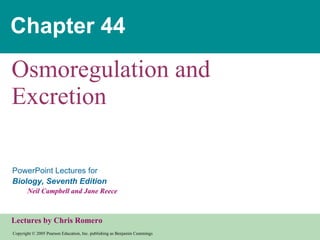Melden
Teilen

Empfohlen
Weitere ähnliche Inhalte
Was ist angesagt?
Was ist angesagt? (20)
Endocrine control of osmoregulation in fish zeinab klaab

Endocrine control of osmoregulation in fish zeinab klaab
Andere mochten auch
Andere mochten auch (17)
Biology - Chp 11 - Introduction To Genetics - PowerPoint

Biology - Chp 11 - Introduction To Genetics - PowerPoint
Ähnlich wie 44 excretion text
Ähnlich wie 44 excretion text (20)
Mehr von Andrew McCaskill
Mehr von Andrew McCaskill (20)
44 excretion text
- 1. Chapter 44 Osmoregulation and Excretion
- 61. Chapter 45 Hormones and the Endocrine System
- 85. Table 45.1